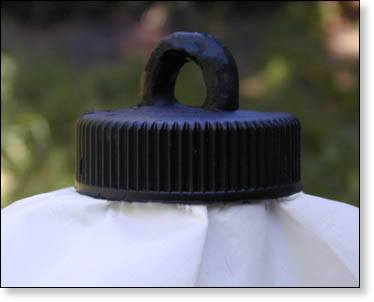
Tent pole clips allow you to attach aluminum, fiberglass, graphite, wooden and bamboo poles and wands to tent coverings, fabrics, flags, sails and kites.
ABSTRACT OF THE DISCLOSURE
A connector connects the end segments of one or more poles and a flexible membrane to form a tent, canopy, kite or other flexible shelter or non-shelter structure. The connector has a first and a second body section that are adapted to mate via loosely coupled threads in one adaptation. A portion of a flexible membrane is retained between the two body sections. The first body section has an open end and is adapted to engage an end segment of a pole. The second body section is adapted to be fitted with a ring, hook, or other structure to which a guy wire, rope, or other pole may be connecte
BACKGROUND OF THE INVENTION
The present invention relates generally to flexible structures such as tents and canopies, and more specifically to flexible structures in which a flexible membrane or fabric overlies and is supported by one or more poles. Still more specifically, the present invention relates to a connector for connecting the ends of such poles with a portion of overlying flexible membrane or fabric.
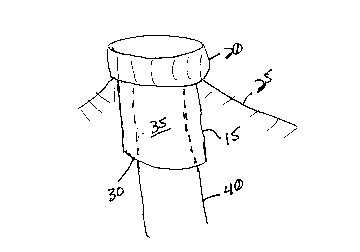
Description of the Prior Art and styles of flexible structures such as tents and canopies
Numerous type exist in the prior art. Flexible tent structures are commonly used for recreational purposes, such as camping. Numerous types and styles of tent structures are known. Many share as a common characteristic that a flexible structure is defined by one or more poles, which are connected to and support a flexible membrane or fabric to define a sheltered space. In some such structures, such as various dome style tents, the poles are resilient and are flexed under tension. In other structures, for example “X’ frame tents, various tensegrity structures, and lean-to’s, the poles may be rigid and generally angled upright from the plane of a base surface, such as the ground. Various means have been used to connect the flexible membrane and the poles in known tent structures. For example, rings, fabric sleeves, and various styles of clips are all known. The inventor of the present invention has patented a number of different flexible structure designs, which include various pole connectors.
Another type of flexible structure, sometimes called a canopy, has often been used to create sheltered space for entertainment or entertaining. For example, canopies are typically used by circuses and other forms of entertainment to create large sheltered spaces for performers and spectators. Smaller canopy style structures are also often used to create sheltered space for various purposes at smaller events. Examples include space for catered food service, a portable dance floor, sun protection, and other purposes. Unlike many flexible tent structures, canopy type structures are often used to define much larger sheltered spaces. Like A7frame style tents and tensegrity structures, such structures typically employ one or more rigid upright poles. A flexible fabric typically overlies the poles and is stretched to the ground or other base surface and held under tension by cables, ropes, stakes, and the like. In many cases, the flexible membrane is not connected directly to the tops of the upright poles, but may be provided with an extra thick protective layer, such as a leather layer, at the points where the membrane contacts the tops of the poles. This is to prevent the poles from tearing through the membrane. In some very large canopy structures, such as some circus canopies, the poles do not contact the overlying membrane at all. In such canopy designs, holes are formed in the membrane at the points where the membrane would contact the tops of the poles. The poles protrude through the openings, and the membranes are connected to the tops of the poles via cables or ropes, rings, etc.
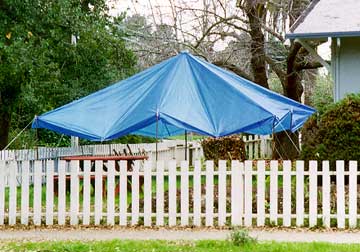 The need to precisely position the flexible membrane in order to align the tops of the poles and the protective layers or holes, and the need in some cases to make additional connections between the poles and the membrane via cables, ropes, etc., make the task of setting up and tearing down flexible canopy structures, A-frame style tents, and tensegrity structures more time consuming and problematic than necessary. Moreover, flexibility in defining a sheltered space is limited when the poles must connect to a flexible membrane at defined locations. What is needed therefore is a connector that can connect the ends of the poles and the flexible membrane in such flexible structures quickly, easily, flexibly, without requiring precise alignment or positioning, and without damaging the membrane. It would also be advantageous for such a connector to be flexible enough in application to be useful in constructing flexible structures other than shelter structures, such as kites and hang-gliders, for example.
The need to precisely position the flexible membrane in order to align the tops of the poles and the protective layers or holes, and the need in some cases to make additional connections between the poles and the membrane via cables, ropes, etc., make the task of setting up and tearing down flexible canopy structures, A-frame style tents, and tensegrity structures more time consuming and problematic than necessary. Moreover, flexibility in defining a sheltered space is limited when the poles must connect to a flexible membrane at defined locations. What is needed therefore is a connector that can connect the ends of the poles and the flexible membrane in such flexible structures quickly, easily, flexibly, without requiring precise alignment or positioning, and without damaging the membrane. It would also be advantageous for such a connector to be flexible enough in application to be useful in constructing flexible structures other than shelter structures, such as kites and hang-gliders, for example.
The various connectors previously disclosed by the inventor (see the above-identified patents) for flexible tent structures are not entirely suitable for the present purposes. These connectors show various means for connecting flexible membranes with resilient poles that are flexed under tension, including a unique two piece clip design marketed under the name “Grip Clip,” and a two piece “barrel” design that employs loosely mating male and female threads to grip a membrane between them. However, none of the foregoing designs are able to connect membranes to the ends of supporting poles to construct certain types of flexible structures like A-frame tents, canopies, and tensegrity structures.
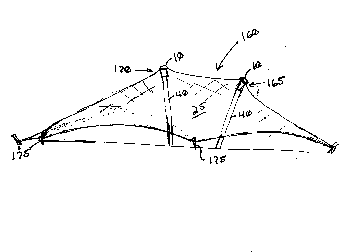 It is an objective of the present invention to overcome these problems and limitations of the prior art, and to provide advantages over previously known means and methods of connecting flexible membranes to the ends of poles in certain types of flexible structures.
It is an objective of the present invention to overcome these problems and limitations of the prior art, and to provide advantages over previously known means and methods of connecting flexible membranes to the ends of poles in certain types of flexible structures.
More specifically, it is an objective of the present invention to provide a connector that can securely connect selected portions of a flexible membrane to the ends of poles in order to construct certain types of flexible structures.
It is a further objective to provide such a connector that eliminates the need to provide a protective layer or hole in the membrane to prevent damage to the membrane.
It is a further objective to provide a connector that eliminates the need to precisely align or position a portion of the flexible membrane with the end of a pole in order to construct a flexible structure.
It is a still further object to provide a connector that eliminates the need to make additional connections between a flexible membrane and a pole in order to securely couple the two.
It is a still further object to provide a connector that makes construction and disassembly of flexible structures easier and less time consuming.
It is a still further object to provide a connector that is flexible in use to construct a wide variety of flexible structures including both shelter defining structures, such as tents and canopies, and other structures, such as tents and hang-gliders.
KiteClips™
Kite clips™ will let you make a huge variety of kites out of most fabrics and plastics.
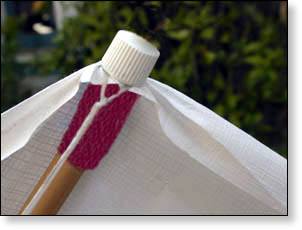
KiteClips™ attach onto most plastics and fabric to provide a secure pole socket for wood, fiberglass, graphite, or bamboo wands.

This kite was make of Tyvek, bamboo and six KiteClips
